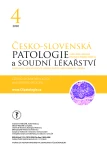Right heart ventricle myocarditis induced by pulmonary thrombembolism
Authors:
Václav Stejskal 1; Jakub Šimka 2; Ivo Šteiner 1
Authors‘ workplace:
Fingerlandův ústav patologie, Fakultní nemocnice Hradec Králové a Univerzita Karlova, Lékařská fakulta v Hradci Králové 1
1; I. interní kardioangiologická klinika, Fakultní nemocnice Hradec Králové a Univerzita Karlova, Lékařská fakulta v Hradci Králové 2
2
Published in:
Čes.-slov. Patol., 56, 2020, No. 4, p. 227-230
Category:
Original Article
Overview
Deep venous thrombosis and pulmonary thrombembolism are referred to as venous thrombembolism. Pulmonary thrombembolism affects the right ventricle. Two morphologically and clinically distinct conditions are distinguished according to change of blood pressure and speed of blood pressure increase in the pulmonary artery - acute and chronic cor pulmonale. Acute cor pulmonale develops during rapid increase (within seconds) of blood pressure in the pulmonary artery. Morphologically, the condition leads to dilatation of the right ventricle and clinically to sudden cardiac death or severe circulatory instability. Chronic cor pulmonale represents myocardial hypertrophy of the right ventricle as a response to the gradually increasing pressure in the pulmonary artery. Herein, we demonstrate a rare case report of right ventricular myocarditis in a 51-year-old woman with pulmonary thromboembolism and morphological signs of chronic pulmonary hypertension. This non-infectious myocarditis is histologically characterized by myocardial damage (myocytolysis) and dominant histiocytic and neutrophil infiltration accompanied by scanty T-lymphocytes. These inflammatory changes differ from those associated with myocardial infarction. The possible pathological mechanisms of right ventricular myocarditis induced by pulmonary thrombembolism are discussed.
Keywords:
pulmonary thrombembolism – cor pulmonale – myocarditis – right ventricle dysfunction
Sources
1. Rokyta R, Hutyra M, Jansa P. Doporučené postupy Evropské kardiologické společnosti pro diagnostiku a léčbu akutní plicní embolie, verze 2014. Cor et Vasa 2015; 50: e275-e296.
2. Šteiner I. Kardiopatologie pro patology i kardiology (1. vydání). Praha: Galén; 2010 : 41-44.
3. Roberts WC, Shafii AE, Grayburn PA, et al. Clinical and morphological features of acute, subacute and chronic cor pulmonale (pulmonary heart disease). Am J Cardiol 2015; 115 : 697-703.
4. Dušek J. Myocardial damage caused by the amniotic fluid embolism. Pathol Microbiol 1962; 25 : 283-293.
5. Dušek J. Morfologické nálezy v srdečních komorách při jejich unilaterálním přetížení. Čs Fysiol 1981; 30 : 111-112.
6. Begieneman MPV, Goot FRW, Bilt IAC, et al. Pulmonary embolism causes endomyocarditis in the human heart. Heart 2008; 94 : 450-456.
7. Orde MM, Puranik R, Morrow PL, Duflou J. Myocardial pathology in pulmonary thrombembolism. Heart 2011; 97 : 1695-1699.
8. Konstantinides SV, Meyer G, Becattini C, et al. 2019 ESC Guidelines for the diagnosis and management of acute pulmonary embolism developed in collaboration with the European Respiratory Society (ERS). Eur Heart J 2019; 00 : 1-61.
9. Watts JA, Zagorski J, Gellar MA, Stevinson BG, Kline JA. Cardiac inflammation contributes to right ventricular dysfunction following experimental pulmonary embolism in rats. J Mol Cell Cardiol 2006; 41 : 296-307.
Labels
Anatomical pathology Forensic medical examiner ToxicologyArticle was published in
Czecho-Slovak Pathology

2020 Issue 4
Most read in this issue
- Chtěl jsem být bankovní lupič, ale nevěděl jsem, kde se na to studuje
- Comments on the 5th edition of WHO classification of digestive system tumors – Part 1. Gastrointestinal tract
- Prof. MUDr. Ľudovít Danihel, PhD. jubiluje.
- Changes in histopathological classification of neuroendocrine tumors in 5th edition of WHO classification of gastrointestinal tract tumors (2019)
